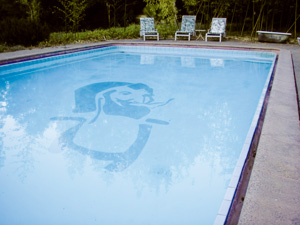Features & Columns
Chateau Liberté
 SUNKEN TREASURE: The pool at Chateau Liberté was graced by the ubiquitous image of the Zig-Zag Man.
SUNKEN TREASURE: The pool at Chateau Liberté was graced by the ubiquitous image of the Zig-Zag Man.
THE ONLY San Jose band ever to make a cameo appearance on the '70s sitcom What's Happening, is currently celebrating its 40th anniversary. The Doobie Brothers began in 1970, releasing their self-titled debut the following year.
The cover of that album showed the band hanging out at Chateau Liberté, a now-legendary biker bar in the Santa Cruz Mountains, where the Doobies got their start. This year, the band releases a new album with a new track, "Back to the Chateau," dedicated to the venue, which existed until the mid-'70s.
"The Chateau," as the mountain ilk still say, was located on a muddy dirt path off Old Santa Cruz Highway, buried amid the gargantuan redwoods. The Hell's Angels ran the place for years, and the parties were over the top. Since the building was down the hill from the main road and somewhat difficult to reach, the sheriffs often just refused to drive all the way in.
Many bands played at the Chateau, including the earliest version of the Tubes and several offshoots of the Grateful Dead and the Jefferson Airplane. Skip Spence of Moby Grape, who had actually introduced the Doobie Brothers to each other, occasionally stayed in a van just outside the chateau. Hot Tuna recorded its live album, First Pull Up, Then Pull Down, at Chateau Liberté. In Jeff Tamarkin's book Got a Revolution, Jorma Kaukonen described the place: "It was a shit-kicking log cabin bar, an old stage stop in 1800s. It had very low ceilings and was down a muddy road. The sound was horrendous. We played there a lot and wanted to do this album there."
Previously, in the late 19th century, the building was a stop on the old Wells Fargo stagecoach line from San Jose to Santa Cruz. From 1920 to 1945 it was Chateau Boussy, a French restaurant and luxury hideaway for high-society types and politicians who needed a spot to bring their mistresses.
But many folks from the Chateau Liberté era still remain and continue to circulate their memories of the place. People of all shapes and sizes attended the festivities to eat, drink and listen to music. It was a communal atmosphere—a temporary autonomous zone of the most inspiring sort.
W.J. McKay, who first frequented the joint as a teenager, recalled how everyone seemed to get along: "You had people that were totally politically opposite, socially opposite," he told me. "Bikers and hippies were about as different as people could be, and yet they totally co-existed up there. They even had their own underground economy going on. Dope had an established exchange rate. Pot was worth so much in weight, for so many hits of acid. The hippies and the bikers totally worked together. They exchanged food, they worked on each other's vehicles, they did chores for each other."
Local real estate agent George Rabe currently owns and lives on the 72 acres where the Chateau sits. He restored the building and remains immersed in its history, so much that he went out of his way to give us a personal tour of the property. Oil painter Paul Berenson, who in 1973 lived in the redwoods right outside the Chateau, even drove up from Santa Barbara for the tour. It was the first time he'd been to the property in 37 years.
"It made me realize how much I didn't appreciate it back then." Berenson told me. "And how big of an influence it was on me. That was my first real appreciation of nature."
The Chateau Liberté scene was true counterculture in the sense that it could only have happened at that particular time and place. It was a uniquely Northern California scenario.
"It wasn't just a legendary rock & roll bar," McKay said. "It was an example of music and people breaking barriers, for better or worse, in one of the most beautiful natural coastal rain forests in the world. It was a scene that will never be re-created, and hopefully never forgotten."


